Backcopies of all issues of the printed magazine and some of the APP are available via the backcopy link
Printed $6.00 (plus postage), App $5.99
To ensure you don't miss any articles in future you can subscribe- for just $43 -through our safe, online system here
ARTICLES from past, magazines,
e-Previews and APPs
UNDER CONSTRUCTION - articles are gradually being linked for access on-line
Travel and Horses in Other Countries |
Transylvania Trail - the rustic charm of Romania
October November 2018 (Pdf)
Wine Lovers trail Ride - France
August september 2018 (Pdf)
Horse trekking in NZ
June July 2018 (Pdf)
The Gobi Gallop by Jenna Arnet
February/March 2018 (Pdf)
Colombia - a challenging ridectober/November 2017 (Pdf)
Riding in Croatia
August/September 2017 (Pdf)
osta Rica Holiday
Aug Sept 2016 (Pdf)
Trekking in the land of the Maasai - Dec/Jan14/15 (Pdf)
Celebrating Horses Around The World
-Oct Nov 14 (Pdf)
Horse Trekking in New Zealand -
Aug/Sept 14 (Pdf)
Chile to Argentina Ride -
June /July 14 (Pdf)
Horsetrekking in France -
April/May 14 (Pdf)
VOLUN-TOURING IN INDIA -
Oct/Nov 13 (Pdf)
IBIZA - horse rescue -
Aug/Sept 13
Turkey Horse Trekking -
June/July 13 (Pdf)
Horse Trekking In iceland -
April/May 13
Skijoring- Skiing by horse power - Feb/March 13
Treating Horses In Egypt -
Dec/Jan 12/13
A New Chinese Dynasty -
Oct/Nov 12
Cambodian Equestrians -
Aug/Sept 12
|
|
SEE ARTICLES UNDER HEADINGS BELOW, SUCH AS TRAINING HORSE TRAINING RIDER, GEAR, VETERINARY, BREEDING, NUTRITION ETC.
OTHER ARTICLES from e-PREVIEWS and APPS ..some available on-line
Gottland Russ or Pony- Pdf DownloadOctober/November 2
015
Peruvian Paso - August/Sept 15
German Black Forest Horse
- June/July 15
Japanese Kiso Horses - April/May 15
Curly Horses - Feb/March 15
The Hungarian Nonius - Aug/Sept 14
Miniature Mediterranean DONKEY (PDF DOWNLOAD) - June/July 14
Equitana 2014 PDF DOWNLOAD- Dec/Jan 2014/15
AYDEN UHIR - Sponsored by NIKE - APR/MAY 14
the 'FELIX' series by New Zealander Katie Haggarth and superbly illustrated by Kay Thornton
The First Show - June July 13
|
ARCHIEVED ARTICLE SELECTION |
TRAINING
Vol 28 - 6 PONYING (leading from another horse)
by Tracy Tillman
Ponying’, or leading one horse off another, is an especially useful technique if time is
short or a health issue precludes mounted exercise.
Vol 32 - 1 WHAT
USE IS DRESSAGE SCHOOLING FOR ME? STEFFEN PETERS AT EQUITANA
by Jennifer Chisholm-Hoibraten
There are many components to the basic dressage foundation of the competition
dressage horse that are pure common sense and are shared by the western
horse, the show jumper, the endurance horse, the camp drafter, the off
track racehorse, the driving horse and the children’s pony.
Vol 32 - 3 PILATES
FOR THE HORSE RIDER
by Annette Wilson
Strong core stability is a crucial element to having a good posture on
a horse and being an effective rider, and it’s something everyone
can learn.
Vol 32 - 2 OVERSHADOWING by Dr Andrew and Manuela McLean
Research suggests that reduced responses to the aids, chronic stress and
learned helplessness may arise from impossible or confusing demands from
riders, such as the simultaneous use of the rider’s legs and reins
– where the horse will choose to respond only to the most significant.
Vol 33 - 2 August September 2011
RIDING CIRCLES
by Hanika Pemberton with ‘Master’ Frederico Saramago.
Having an understanding of the Classical Horsemanship foundations may give riders a taste for the art of working their horse towards a level of education, and consequently, obedience from which to progress to higher ideals.
Vol 33 - 3 October November 2011
OVERCOMING WATER CROSSINGS
by PAT PARELLI
The image of horse and rider splashing gently through a creek on a warm afternoon, sun glittering on the water is an irresistible picture, but it is not a likely scenario for many riders without a solid foundation in place.
Vol 28 No 2 Aug/Sept 2006
The ART OF LUNGEING - Running Reins
by Liz Tollarzo
An artificial aid that can be useful for some lungeing situations. Running reins are simple devices for encouraging lowering of the head and a more rounded outline.
Vol 29 No 1 June July 2007
THINK LATERAL
by Wendy Murdoch
Learn how the humble zucchini and a table top can be useful tools for learning lateral movements.
Vol 30 No 2 August/Sept 2008
DEMYSTIFYING DRESSAGE - Part 1 - Transitions by Coralie Smyth
This systematic and sequential method of training outlines the breakdown of the essential components for riding Grand Prix dressage and enables every horse and rider to ride these high level movements. Transitions receive more marks than any other movement and should comprise a major part of every training session.
Vol 31 - 6 April/May 10
HORSE TRAINING THEORY
By Dr. Andrew and Manuela McLean
The outcome of every interaction between horses and humans, both in-hand and under-saddle, depends on a horse's mental abilities, its instinctive tendencies, its learning processes and its biomechanical potentials.
Vol 27 - 3 Oct/Nov 2005
SIT THE HORSE ON THE BIT
By by Richard Weis
Photos by Alois Muller
Reproduced from Dressage Today
Richard Weis has drawn record
crowds at the German Olympic Training Centre by giving top European dressage
riders new tools to gain a more effective seat. Inspired by a phrase from
a German text, the work has become his passion and his life.
Vol 31-6 April May 2010
AN INDEPENDENT SEAT
by Jane MYERS
Developing an independent seat involves more than just the rider’s bottom in the saddle – several body parts need to work together – and the first in this three part series begins with the feet, ankles and lower legs.
Vol 32-4 Dec Jan 2010/11
THE WALK by Bert Hartog
While some riders may see the walk as a rest period, not as another pace that should have the same impulsion and quality as the trot or canter, it is recognised as one of the most difficult to perform correctly.
Vol 33-1 June July 2011
IMPROVING THE TROT by Bert Hartog
A pace used extensively in dressage tests, the trot is the most important pace of all, and as a movement carries a higher score in tests when performed correctly.
Vol 35-1 June/July 2013
MOUTHING THE YOUNG HORSE
Halter exercises for yielding and flexion must be well established before introducing the bridle.
Vol 35 - 1 June July 2013
Sandi Simons- LEG CONTROL
by Sandi Simons
A rider should not have to constantly ask their horse to move forward, get off their inside leg, stop falling out through the shoulders or stop falling in on the circle.
Vol 35-3 Oct/Nov 2013
RIDING FORWARD WITH LINDA PARELLI
Many behavioural issues can be caused by not riding the horse forward. Riding forward with energy and control can solve many problems.
Vol 35-6 April May 2014
RENVERS- Lateral Exercises
by Liz Tollarzo
Lateral exercises improve a horse’s physical and mental flexibility and lay the foundations for complex movements in many disciplines.
Vol 38-2 August September 2016
THE ART OF REWARD
by Sarah Warne
There is a vast difference between a firm and effective rider and a firm and forceful rider, with the difference being in the art of letting go. Knowing when to release the pressure, soften the reins, relax the legs… and having the art of knowing when to say... thankyou!
GENERAL
Vol 23 No6 April May 02
THOSE BIG BOUNCING BOOBS PDF download
by Di Rowlings
Big bouncing boobs are not necessarily a bonus for female riders.
Vol 30 no4 Dec/Jan 08/09
WHAT GOES UP...A PDF DOWNLOAD
by Wendy Murdoch
For the well endowed lady rider. Big breasts might be beautiful, but for women with a lot of bounce
up top, riding can be a less pleasant experience.
Vol 30 - 5 Feb/March 09
WHEN IT'S WOBBLERS
A Reader's Story by Penny Lee
When Wobblers was first suggested as a diagnosis this owner did everything she could to give her young Warmblood a fighting chance, but sometimes fate decrees that no matter how much you do, it will not change the outcome.
Vol 36 - 1June July 14
DO HORSES RECOGNISE THEIR HANDLERS ?
by Kaye Meynell
Recent research proves that horses are able to discern between different people, and cannot just positively identify a familiar person from a stranger, but can also distinguish between several familiar people.
Vol 35-3 Oct/Nov 2013
READER'S STORY- IN SEARCH OF A BRUMBY
Taking part in a Brumby Safari enabled Deb Bloomfield to make a special connection with a wild horse.
Vol 35 - 6 April May 14
SELECTING A FLOAT
by Kaye Meynell
We invite our Facebook followers and readers to have their say about their experiences when purchasing a float.
Vol 36 - 3 Oct/Nov 14
MAKING THE STABLE BED
There are several methods of mucking out or cleaning a stable, and deciding which one is best will likely depend upon time constraints and cost for the owner, the bedding used and also the horse’s behaviour when stabled.
Vol 36 - 4 Dec/Jan 14/15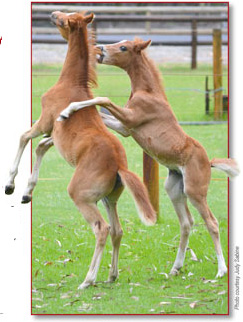
THE IMPORTANCE OF PLAY
by Kaye Meynell
Researchers look at the question of why animals play and the benefits and disadvantages of play in the young horse. Both the short and long term benefits have yet to be clearly defined and agreed upon by those studying it.
Vol 39 - 1 June July 2017 (digital)
IT'S OK TO OWN A PADDOCK ORNAMENT
by Andie Wyatt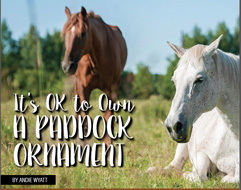
Keeping horses without using them might seem wasteful or pointless to some, but there are many ways and reasons to have horses in our lives without there being a saddle in sight.
Vol 40 - 2 Aug/Sept 2018
GROOMING FOR SUCCESS
by Kaye Meynell
There’s many reasons why owners should be grooming their horses; the techniques, equipment and products varying as highlighted by a number of successful competitors - Lyndal Oatley (dressage), Chanele Hunter-Cooke (show horses), Rachel Watts (eventing) and Stokes Sporthorses (dressage and eventing) - who share their approach and tips.
Vol 40 - 3 Oct/Nov 2018
BULLYING IN EQURSTRIAN SPORTS
by Kaye Meynell
Whether physical, verbal, social or online, bullying causes real harm to those targeted and significantly affects wellbeing. It can occur anywhere - in school, on the sporting field, in the workplace or home – and in a myriad of ways.
Reports of bullying in the equestrian world – both on the yard and the competition field - are becoming increasingly common, but is this truly a reflection of an industry where poor conduct is viewed as acceptable or is it the result of confusion overwhat constitutes bullying behaviour?
Vol 40 - 6 April May 2019  (digital issuu) (digital issuu)
WHERE THERE’S A WILL
by Wendy Elks with the Equine Team from law firm Jansen, Walsh and Grace.
You care deeply for your horse and ensure their every need is provided for, but what would happen in the event of your death? It’s a good idea to consider what could happen and if plans should be put in place for their on-going care and your wishes.
Vol 40-6 April May 2019
CARING FOR YOUR ARENA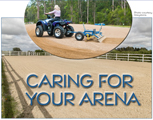
by Kaye Meynell
If your property’s facilities include an arena it’s important that this asset is constructed and maintained properly, for your horse’s safety and the arena’s longevity and usefulness.
Vol 42 - 5 Feb/March 2021
HOOFPRINTS ON YOUR HEART (digital)
byKaren Watson
Sometimes there is one horse that we develop such a strong bond with that it transcends the usual horse/human relationship. These are known in the industry as heart horses.
GREEN HORSE - LAND MANAGEMENT
Vol 34 -6 April May 2013
ESTABLISHING NATIVE GRASSES- Cool Season Types
by
Dr. Ian Chivers
Cool season grasses are those that establish best in months when moisture is readily available to the seed. They include such beneficial native grasses as weeping grass, wallaby grass and wheat grass.
Vol 31 - 3 Oct/Nov 2009
A
STABLE IN THREE DAYS by Wendy Elks
Vision and planning, and a husband with a structural engineering degree,
promptly saw a lifestyle property evolve into one idea for horses.
Vol 42 -3 Oct/Nov 2020
HORSES AND HONEY BEES by Wendy Elks
As beekeeping is becoming more popular many horse owners are starting to question what is involved and if bees can share the property with their horses.
RIDER TRAINING
Vol 26 -5 Feb March 2005
THE PELVIC FLOOR (PDF DOWNLOAD) by Lesley Goff
Riders who wish to improve their overall performance need to consider the pelvic floor muscles. Aside from the function of holding up the contents of the pelvis, this muscle group is also instrumental in supporting and stabilising the lower back.
Vol 28 - 5 Feb/March 2007
LESS IS MORE WITH BRETT PARBERY
by Liz Tollarzo
Successful dressage trainer and competitor, Brett Parbery, uses the philosophy of ‘less is
more’ for his teaching and training techniques.
Vol 32 -3 Oct Nov 2010
MASTERING MOVEMENT by Peggy Cummings
Learning how to unlock the rider’s joints also unblocks the horse’s energy, making riding effortless and allowing horse and rider to move in harmony.
Vol 33-1 June July 2011
BETTER BACK=BETTER RIDE by Heather Sansome
Training the horse to engage its hindquarters, or come through or over its back is dependant on not jsut the horse but also the rider and whether they can engage their own back muscles.
Vol 35 -2 Aug Sept 2013
HAND POSITION AND CONTROL by Sandi Simons
The reins connect a rider’s hands a directly to the horse’s mouth. An independent seat will ensure that that the hands are used for communication not for balance
Vol 36 -3 Oct/Nov 2014
SPURS by Felicity Wischer
When and why a rider would use spurs is discussed by four experienced trainers -Amanda Ross - Eventing Olympian with NCAS level 3 qualifications in eventing and dressage; Dan Maloney - experienced horse trainer and starter of young horses; Heath Ryan - has represented Australia in eventing and dressage at WEG and Olympic level; and Dr Andrew McLean - a successful competitor with a PhD in equine cognition and learning
Vol 36-3 October Nov 2014
SEPARATION ANXIETY by Kaye Meynell
Some horses make strong attachments to other horses and have a difficult time dealing with separation from one or more herd mates.
Vol 36-5 Feb March 2015
RATE THEe HORSE by Dan Steere - Double Dan
Understanding how much the horse understands about any new movement and having a picture in mind of what a perfect 10 rating will look or feel like, will go a
long way to helping horses interpret what the rider is asking.
Vol 40 - 1 June July 18
IN THE SADDLE AT A CERTAIN AGE
THE OLDER RIDER SERIES PART !
by Felicity Wischer
Given Australia’s ageing society it’s perhaps not that surprising that the numbers of older riders in the equine community is growing, and many make a return to the saddle after years out of it.
Vol 40 - 5 Feb/March 2019 (ISSUU)
HOW DOES A FOAM ROLLER IMPROVE YOUR RiDING  (issuu) (issuu)
by Kat Dent
For anyone who is wondering what a foam roller is, and what it has to do with horse riding, Kathleen Dent from KDM Massage and Wellness Centre in Diamond Creek, Victoria, shares her experience with this beneficial piece of equipment.
Vol 40 - 5 Feb/March 2019 (ISSUU)
GROUNDWORK EXERCISES for thE OLDER RIDER
by Felicity Wischer
The advantages of groundwork are many, no matter the discipline you’re pursuing with your horse. For the older rider the principles of groundwork are advantageous for horse and rider for improved control and a safer experience when handling or riding.
 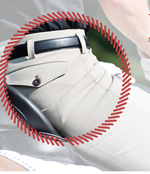 HIP HIP
PAIN
SERIES
Vol 41 - 1 June July 2019
HIP PAIN - tips for rider comfort -
Pt 1 Hip Pain Series
by Deidre Rennick
Few riders will not experience some wear and tear in their bodies as a result of ageing and the physicality that can come with riding and horse ownership. Osteoarthritis is a condition that many riders find themselves dealing with, which will impact their time in and out of the saddle.
Vol 41 - 2 August September 2019 
RIDING WITH A NEW HIP
Part 2 Hip Pain Series
by Deidre Rennick
Following on from last issue’s article on Hip Pain, for riders requiring a hip replacement being prepared and knowing what to expect is important in their quest to get back in the saddle.
Vol 41 - 2 Oct-Nov 2019 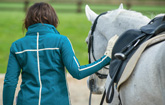
REHAB BEFORE RIDING -
Part 3 Hip Pain Series
by Deidre Rennick
The third part in the series on riders requiring a hip replacement, the rehabilitation process is one that should not be rushed as you manage your recovery and work towards getting back in the saddle.

Vol 41 - 3 October/November 2019
100mile (160km) A MONTH CHALLENGE to walk with your horse
by Steve Halfpenny
Work your horse in-hand for an hour a day, across all terrain, to develop a connection.
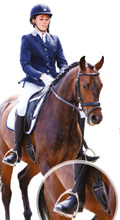
Vol 41 - 6 April May 20 (ISSUU)
LEGS, LEGS, LEGS
by Jemma Moon
How leg strength can affect your riding balance and effectiveness.
Vol 41 - 6 April May 20 (ISSUU)
Pole Exercises by Saidee Samuelson
You’ve got your poles set up and practiced the exercises introduced in the last issue. Now Saidee Samuelson from Equestrian Pole Club shares some new, fun and challenging exercises.
HOW-TO
Vol 28 - 5 Feb/March 2007
MAKE YOUR OWN RIBBON BROWBANDS
by Sharon Robinson
Follow this easy, step-by-step guide to create a fashionable ribbon-covered browband in
colours to suit your horse or pony
Vol 43 - 5 Feb/March 2020
HOT HORSE HACKS (digital) 
by Andi Wyatt
These hacks provide ways to brighten every horse’s day, keeping them amused and perhaps a little cooler during those long hot hours
BREEDING
Vol 32 - 3 Oct/Nov 2010
COMPETENCE AND CONTROL- showing stallions safely
by Julia McLean
Stallions in the show ring ooze virility and masculinity – they fairly sizzle with life. However anyone who has spent any amount of time at horse shows will more than likely have had some experience of seeing a problem caused by an unruly or mis-managed stallion.
Vol 32 -4 Dec Jan 2010/11
LAVENDER FOAL SYNDROME by Carol Willcocks
Researchers identify the mutation responsible for LFS, a lethal disorder found in Arabian horses.
Vol 33 - 3 Oct/Nov 2011
REPRODUCTION- the mare's cycle
by Drs Allan Gunn, John Chopin and Jim Rodger. Equine Veterinarians Australia
The reproduction cycle of the mare is an intricate series of events leading to the ultimate outcome of producing a foal, and understanding these events may explain the often erratic behaviour of the mare
Vol 35 - 4 Dec Jan 2013/14
BEHAVIOUR OR PMS
by DR JENNIFER STEWART. Equine Veterinarians Australia
Understanding the so-called 'Mareish' behaviour of the performance mare when cycling can help with managing the problem.
Vol 2 - 5 Feb/March 2021
SLEEP DEPRIVATION(digital)
By Dr Tom Ahern
Is your horse crazy...or just tired and irritable?
Just how much sleep does your horse need?
|
|
GEAR
Vol 35 -2 Aug Sept 2013
WHY THAT GIRTH Part 2 by Kaye Meynell
From a mere handful of styles a decade ago to the multitude of styles and materials available today, choosing the correct girth has never been more complex.
Vol 41-3 Oct-Nov 2019
SADDLE FIT FUNDAMENTALS by Kaye Meynell
We go back to basics and  take a look at what a well-fitted saddle should look like, recognise the detrimental effects that can occur from using a poorly fitted one, and discuss what options riders have if their saddle is missing the mark. take a look at what a well-fitted saddle should look like, recognise the detrimental effects that can occur from using a poorly fitted one, and discuss what options riders have if their saddle is missing the mark.
NUTRITION
Vol 34 -6 April may 2013
FEEDING THE SICK OR INJURED HORSE
by
Dr. Stephen Duren, Ph.D. Hygain Feeds
Feeding the sick or injured horse is not just a matter of providing feed and water – protein and energy requirements are elevated and need to be addressed.
Vol 36 -1 June July 2014
NUTRIGENOMICS by Geoff McLean
Research into the genetic material of humans and equines has seen major advances within the last decade and it is the result of this research that could influence horse management, performance, breeding and feeding in the near future.
Vol 35-6 April May 2014
WHAT CONTROLS APPETITE IN HORSES?
by Dr Jennifer Stewart
Appetite is the sum total of internal factors that either stimulate or inhibit hunger, and the primary driver of appetite in horses is to meet energy requirements.
Vol 40 - 2 Aug Sept 2018 (digital)
PROTEIN- how much and when to feed it.
by Antoinette Foster 
Many horse owners are under the incorrect assumption that protein is actually an energy source, however it has a different function, as protein chains of amino acids are the building blocks for growth and repair of bones, muscles, and almost all of the soft tissue in the horse’s body.
Vol 41-1 June July 2019
FEEDING YOUR OLDER HORSE
THROUGH WINTER
by Larissa Bilston
Keeping condition on older horses through winter can be a worrying problem for many horse owners, but the two most important things you can do are also the two easiest.
Vol 42 -6 April May 2021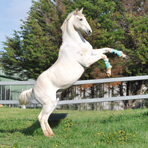
THE OLDER HORSE - performance to retirement
by Jennifer Stewart
Recognising the changes associated with ageing can help owners better manage their horse’s requirements through the ageing process with regards to competing, exercise, feeding, body condition and overall needs.
VETERINARY
Vol 26 -6 April May 2005
BLEEDERS (PDF DOWNLOAD) byTracey Tillman
Though widely attributed to the racing industry, the condition known as 'bleeding' can also affect performance horses in any sport that involves strenuous exercise.
Vol 30 -2 August/Sept 2008
HEAD TRAUMA by by Dr Chris O'Sullivan and Dr Tamara McElroy (EVA)
A blow to the head may appear to be nothing more than a surface injury yet, underlying damage, if severe, could have long-term effects on the horse's health and performance.
Vol 31 - 5 BIG
HEAD by Dr Jennifer Stewart
A disease caused by oxalates present in certain tropical
grasses, which inhibit the absorption of calcium, leading to distortion
of the facial bones, ill-thrift and lameness.
Vol 30 No 6 April/May 2009
A SLIP OF THE TONGUE by Dr Shannon Lee
A good blood supply enhances healing of this important organ, which has a far greater role than just as an aid to eating.
The Art of Lungeing
ng lowering of the head and a more rounded outline.
Vol 30 No 3 Oct/Nov 2008
CONTRACTED TENDONS
by Dr Jennifer Lugton - The Equine Veterinarians Australia (EVA)
While some foals are born with contracted tendons, a painful and debilitating condition that can affect more than one joint, other foals or adult horses can develop it later in life.
Vol 30 No 4 Dec/Jan 2008/09
TENDON AND LIGAMENT THERAPY IN THE COMPETITION HORSE
by by Dr Kirsten Neil - The Equine Veterinarians Australia (EVA)
Tendon and ligament injuries are a common cause of lameness and loss of use in performance horses, and early detection could be the difference between a few months off work or an extended spelling period.
Vol 33-1 June July 2011
MICROCHIPPING by Julia McLean
Without a data base for retrieving information, the micro-chip may not identify horses in an emergency.
Vol 34 - 3 Oct/Nov 2012
DEFEATING THE SARCOID DEATH SENTENCE
by Cheryl McGaffin
This reader’s story documented the search by Cheryl McGaffin from the Mornington Peninsula, Victoria for something to help manage her gelding, Daniel, after he was diagnosed with sarcoids.
Cheryl tried numerous conventional treatments and natural therapies before she took steps to import a topical cream that was available in the U
Vol 35 - 1 June July 2013
CORONARY BAND INJURIES
by by Dr Luke Wells-Smith BVSc
While injuries to the coronary band range in severity, prompt attention may prevent any ongoing issues with lameness.
Vol 36 - 6 April/May 2015
BIOSECURITY
by Dr Jennifer Stewart
Would your horses be protected if there was an outbreak ofdisease within Australia?
Biosecurity is what you do to reduce.
Vol 36 - 6 April/May 2015
DIAGNOSING LAMENESS IN THE EQUINE ATHLETE
by Dr Max Hall
Lameness can originate in bone or soft tissue and being able to identify and understand this condition requires the ability to distinguish between normal and altered paces and the change in the way the horse normally carries itself.
Vol 27 - 2 Aug/Sept 2005
LATERAL THINKING
with Dr Paul McGreevy
by Amanda Macpherson
Groundbreaking new research (at the time) on the equine population was set to dispel the long-held belief that right or left sidedness was something only seen by humans.
Vol 27 - 4 Dec/Jan 2005/06
ROSS RIVER VIRUS by Dr Jennifer Stewart
Paving the way to understanding and addressing the transmission of Ross
River virus into the equine population.
Vol 28 - 2 Aug/Sept 2006
EARLY DETECTION OF FOALING PROBLEMS
by Dr Cameron Collins ( Equine Veterinarians Australia)
Early recognition of problem signs during a ,are's pregnancy, during the birthing process and in the first hours of a foal's life can be the difference between life or death outcome.
Vol 35-6 April May 2014
ANGULAR LIMB DEFORMITIES IN FOALS
by Dr Maxwell HALL
Left untreated, angular limb deformities are likely to cause problems as a horse matures. Early action minimises these risks. .
Vol 30 - 1 June/July 2008
STIFLE LOCK
by Dr J H Stewart
Equine Veterinarians Australia (EVA)
A horse’s ability to sleep while standing enables it to rest on its feet, ready to flee at a moment’s notice. It involves hooking one of the stifle ligaments over the end of the femur. But, sometimes the ligament won’t unhook, and the joint can remain locked when the horse doesn’t want it to.
Vol 32 - 2 Aug/Sept 2010
VETTING VIA THE INTERNET
by Tom Moates
The internet can be a valuable tool in gaining information – but how much of this should be taken into account when faced with a sick or injured horse?
"My horse has been down in the pasture for two days, what should I do?" Although a horrifying entry to read, incredibly this is one of the many posts which can be seen on various internet forums.
Most people with horses in their care would know that a horse 'down' is a medical emergency requiring the vet right away to assess the situation - or would they?.
Vol 37 - 4 Dec/Jan 2015/16
BANDAGING WOUNDS
by Kaye Meynell
Whilst the thought of cleaning and dressing a wound properly can be a daunting task, it is important that it is undertaken in a timely and efficient manner in order to achieve a good outcome - not just in an aesthetic sense but also to maximise the speed of healing and prevent further problems down the track.
Vol39 - 1 June July 17
LAMINITIS ( download the pdf)
by Dr Jennifer Stewart
The protective effects of ice water can prevent the development and progression of laminitis.
And today (even after over 2000 years of study) the only proven therapy to prevent acute laminitis is the application of cold water from the knees and hocks down to the feet.
Vol 40 - 2 Aug Sept 2018 (digital)
WOUNDS THAT WON'T HEAL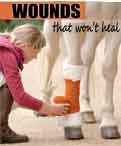
by Dr Jennifer Stewart
We all know that horses and wounds go hand-in-hand – and it is a case of when it will happen, not if!
But why do wounds not heal as expected?
Vol 40 - 4 Dec/Jan 2018/19
STRESS - how do we know if our horse is stressed?
by Dr Jennifer Stewart
An important topic that all horse owners should be aware of.
The way we manage our horses could be causing their stress levels to increase. Checking out the five freedoms related to a horses welfare and comfort will help us recognise and reduce their stress levels.
Vol 40 - 4 Dec/Jan 2018/19
STABLE STORAGE -how do I store all my stuff?
By Nicole Groves
The dilemma that so many equestrians face in their life with horses is not always to do with finding stabling or riding in events, as those issues are easily solved for most of us. The big issue seems to be... “how do I store all my stuff?”
Vol 40 - 5 Feb/March 2019
VITAL SIGNS
by Dr Jennifer Stewart
Horsemen and horsewomen appear to have this in-built ability to 'scen' their horse or horses for any injury or signs of illness, and appear to do so automatically every time they see them. However, it is often the changes that we can’t see that are more important and recognising and taking steps to check when something is ‘not quite right’ is an important aspect of horse management.
Vol 40 - 6 April May 2019
HORSE MEDICATION AND YOUR HEALTH
by Sharon Platten
Horse owner Sharon Platten shares her experience of using a vet-prescribed drug for her horse.
What happened to Sharon should be a warning to everyone handling veterinary drugs and a ‘wake-up’ call that these drugs need to be treated with respect, and appropriate safety measures taken.
Vol 40 - 6 April/May 2019
LAMENESS
by Dr Jennifer Stewart
While lameness in horses cannot be prevented, it can be minimised when we understand the factors involved in its development. Horse owners should educate themselves in the most common lameness conditions that affect their horse’s breed, type, conformation, and discipline. Learn about the relationship between conformation and lameness and work with your farrier to match conformation to use, hoof care and shoeing.
Vol 41 - 1 June July 2019
I CAN HEAR SAND
by Dr Jennifer Stewart
Sand accumulating in a horse’s gut can be the result of a number of factors, but it is a concerning health issue for horse owners. Dr Stewart looks at ways to minimise sand accumulation and management processes to reduce the risk factor.
Vol 41 - 2 August September 2019
LYME DISEASE IN AUSTRALIA
by Dr Jennifer Stewart
So what is Lyme Disease? While the tick that transmits this condition has not been identified in Australia there are many instances of people and horses suffering from Lyme-like symptoms. How, why and where can it occur, and what can be done about it?
Vol 41 - 2 August September 2019
HORSES THAT FALL THROUGH THE CRACKS
with Dr Kylie Brkusich by Kaye Meynell
Despite the advancements and research in equine veterinary care some horses health issues can be difficult to diagnose, treat and manage, resulting in horses that are heading for the retirement paddock - when they really don’t need to be there.
Vol 41 - 3 October/November 2019
NO SWEAT
by Kentucky Equine Research
When your horse is unable to sweat it can rapidly accumulate more heat than it can easily eliminate, resulting in high body temperatures that can lead to incoordination, unwillingness to continue exercise, collapse, convulsions, and even death.
Vol 41 - 3 October/November 2019
POULTICE IT
by Dr Jennifer Stewart
Depending on the ingredients and how they are applied, poultices are designed to ease bruising and to relieve pain, swelling, inflammation and infections.
Vol 41 - 3 October/November 2019
GELDING SCARRING
by Wendy Elks
While there can be some complications with the equine gelding procedure, gelding scarring is an issue that many are unfamiliar with.
Vol 41 - 4 December January 2019/20
PNEUMONIA
by Dr Jennifer Stewart
Although any horse can be affected, generally stressed horses that travel and compete, old, undernourished, debilitated horses and foals are most at risk.
Vol 41 - 5 Feb/March 2020
ANAEMIA
by Dr Jennifer Stewart
It's not an illness, it is a symprom of something wrong elsewhere in the horse's body.
Vol 41 - 6 April May 20 (digital)
PAIN IN THE JOINTS - Equine arthritis
by Dr Jennifer Stewart and Equine Veterinarians Australia
An incurable condition that can affect many horses, there are different types of arthritis and a range of symptoms that can be present with the condition.
Vol 42 -2 Aug/Sept 2020 (digital)
PREVENTING AND REDUCING COLIC
by Dr. J. H. Stewart
Colic describes signs of abdominal pain or discomfort and is a symptom rather than a disease.
Vol 42 -3 Oct/Nov 2020 (ISSUU)
Sore Eye? What to do
by Dr Brianna Clark and Dr Allison Stewart
With their position on the head, a horse’s eyes can be quite prone to injury and damage with corneal ulcers the most common cause of eye problems.
Vol 42 -3 Oct/Nov 2020 (digital)
SWOLLEN LEGS
by Dr. J. H. Stewart
Swelling in horses’ lower legs is pretty common and usually happens if horses move less than normal - like standing in a yard or stable at night..
Vol 42 -4 Dec/Jan 20/21(digital)
DEHYDRATION, REHYDRATION, and Electrolytes
by Dr. J. H. Stewart
With the weather heating up it’s important to ensure your horse’s water intake is adequate and electrolyte losses over those provided in their feed are replaced after exercise.
Vol 42 -4 Dec/Jan 20/21
SEVEN WAYS TO IMPROVE THE HORSE'S GASTROINTESTINAL TRACT
 by Erika GoughWith research showing that the horses microbiome is involved in more that just digestion, equine nutritionist Erika Gough explains why it is important to maintain its health for the overall wellbeing of our horses. by Erika GoughWith research showing that the horses microbiome is involved in more that just digestion, equine nutritionist Erika Gough explains why it is important to maintain its health for the overall wellbeing of our horses.
Vol 42 - 4 Dec Jan 20/21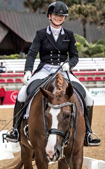
TRAINING TIPS
with Mary Warren - Dressage Coach Mary Warren shares her tips on improving the horses responsiveness to the aids, addressing a lack of balance and harmony, her weekly training plan and preparing for a competition.
Vol 42 -5 Feb/March21 (digital)
Equine Bladder Stones
STONES IN YOUR HORSE'S URINARY TRACT
by Dr Jennifer Stewart and Equine Veterinarians Australia 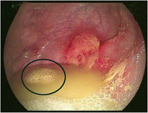
While not a common problem, and associated more often with male horses, the presence of stones in the horse’s urinary tract can lead to pain and infection, and the risk of life threatening complications.
Vol 43-1 June July 2021 (issuu)
SALMONELLA
by Dr Jennifer Stewart
Extremely contagious and one of the most commonly diagnosed infectious causes of diarrhoea in adult horses, Dr Jennifer Stewart explains the signs of illness, how it is transmitted, diagnosis and treatment, and what you should consider for your property biosecurity plan
Vol 43 -2 Aug/Sept 2021 (ISSUU)
KIKUYU AND YOUR HORSE'S HEALTH
by Dr. Jennifer H. Stewart
Good pasture represents oneof the best and least expensive sources of food for horses - and it provides the most natural and healthy environment for exercise and rest.However, there are three main concerns with kikuyu grazing that need to be taken into consideration.
Vol 43-3 October November 2021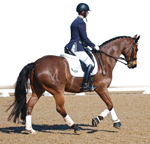
DEVELOPING THE TOPLINE
by Dr Jennifer Stewart
The back is one of the most important areas of the
horse, allowing the horse to support its own weight and to carry a rider.
Vol 43-5 February March 2022
CHOKE (Issuu)
by Dr Jennifer Stewart
Choke is a serious, painful crisis for horses that can last several hours or even days - but is not usually a life-threatening one if it is treated and resolved early.
FARRIERY/HOOF
Vol 41-1 October/November 2019
DON’T RASP THE PROTECTIVE HOOF LAYER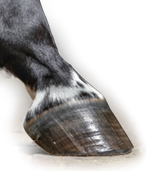
by Peter Kay
We’ve all heard the expression ‘No Hoof, No Horse’, but how well do we understand the importance of the hoof wall and its role in keeping the hoof healthy.
Vol 43-4 December/January 2021/22 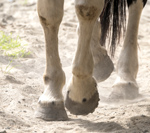
SUMMER FEET
by Dr Jennifer Stewart
As the seasons change, so do your horse’s hooves. Every season affects the equine hoof
differently - and summer can be especially challenging with hot, dry days that can affect horses’ feet enough to cause you to rethink your hoof care strategy.
DISCIPLINES /SPORTS
Vol 43-1 June July 2021 (issuu)
BEGINNERS GUIDE FOR AN ENDURANCE RIDE
Ever considered trying the popular sport of Endurance?
With some planning and commitment you can work towards participating in your first ride with this step by step feeding and training guide.
|
| |
|
|
| |
|
|
| |
|
|